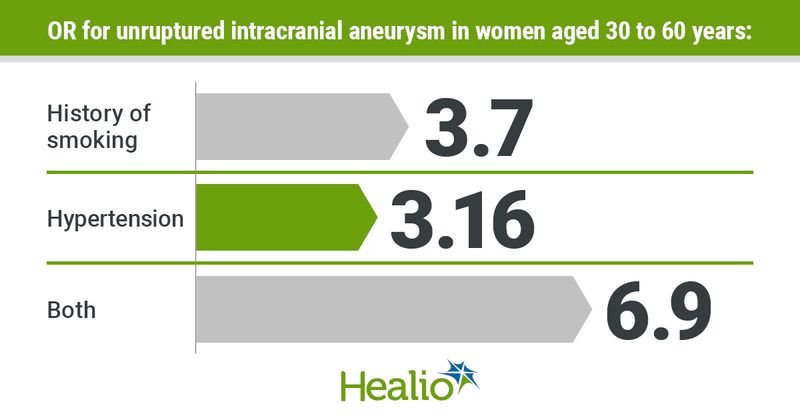Women who smoke at greater risk for unruptured brain aneurysm
Women who smoke are four times more likely than those who do not smoke to have an unruptured brain aneurysm, according to a study published in Journal of Neurology Neurosurgery & Psychiatry.
“There are an estimated 6.5 million people harboring an unruptured intracranial aneurysm (UIA) in the United States,” Christopher S. Ogilvy, MD, director of endovascular and operative neurovascular surgery at the Beth Israel Deaconess Medical Center Brain Aneurysm Institute and professor of neurosurgery at Harvard Medical School, and colleagues wrote.

Previous studies, they added, have shown “a clear association between smoking and the likelihood of having an aneurysmal growth and subsequent rupture,” and that UIAs are more common among women.
Current guidelines recommend screening for UIA in patients with two or more family members with a history of brain aneurysms and those with autosomal-dominant polycystic kidney disease, according to the researchers.
Ogilvy and colleagues conducted a multicenter matched case-control study of women with an incidental UIA diagnosis from 2016 to 2018 who were included in a database of magnetic resonance angiographies performed in five large academic hospitals in the U.S. and Canada.
The participants were aged 30 to 60 years and did not have medical history of UIA or a family history of UIA, aneurysm rupture, connective tissue disorders or any other cerebrovascular anomalies.
The researchers matched participants with controls based on patient age and ethnicity and conducted a multivariable conditional logistic regression to assess the differences in smoking status and hypertension in UIA cases and controls.
Of 545 eligible patients, 113 patients with UIA and 113 controls were included in the study. Among participants, the most common reason for MRA was for chronic headaches, which was cited as the reason in 62.5% of UIA cases and 44.3% of controls.
Among women with UIA, 57.5% had a history of smoking compared with 37.2% of control patients.
Ogilvy and colleagues determined that women with a history of smoking had an elevated risk for UIA (OR = 3.7; 95% CI, 1.61-8.5) compared with those who did not. Those with chronic hypertension also had a higher risk for UIA (OR = 3.16; 95% CI, 1.17-8.52).
According to the researchers, the risk for incidental UIA was even greater in women who had both a history of smoking and chronic hypertension (OR = 6.9; 95% CI, 2.49-19.24).
“These data provide further evidence that women aged between 30 and 60 years with a positive smoking history have a high risk for harboring an incidental UIA, which is amplified by the presence of chronic hypertension,” Ogilvy and colleagues wrote.
They added that the findings suggest that women this age with a history of smoking may benefit from a recommendation for UIA screening.
